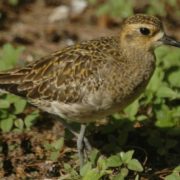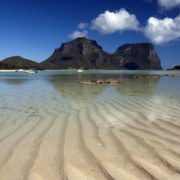The Kolea Return to Kauai Marking an end to Summer

The first Pacific Golden Plovers of the season have arrived in Hawaii and can be seen foraging on soccer fields, parks, golf courses, and even lawns. This event marks the end of summer
Kolea, as they are known in Hawaii, spend their summers in Alaska foraging, mating, building a nest and waiting for their chicks to hatch. But, as the season begins to change, these small birds (weighing merely a half pound) begin to bulk up on food in order to gain enough weight to sustain them on the long journey from Alaska to Hawaii. Amazingly, these territorial birds will return to the same patch of grass every year, vehemently defending it if necessary.
Just a few days after their chicks hatch, they will leave them to fend for themselves, flying nonstop for over 70 hours, and traveling at sustained speeds of up to 70mph. When they arrive in Hawaii, they will have lost about half of their body weight, and will begin foraging once again.
The Polynesians were known to have had an intimate relationship with the Kolea. It has been speculated that the Hawaiians may have even discovered their islands by following the migration patterns of the golden plover. It was these ancient mariners, that followed the clues that nature left for them: wind and wave patterns, the position of the stars, the presence of seabirds, their timing and the direction that they flew.
Even the naturalists aboard Captain Cook’s vessel noted the presences of the Golden plover in Tahiti, but the Tahitians informed Cook’s crew that these birds did not nest in the islands, but instead flew north each spring. If they flew north each spring to nest, Cook speculated that their nesting grounds might just lie in the “Great Southern Continent” that they were seeking. His crew would come across these same birds a decade late, in their search for the Northern Passage.
The Kolea’s flight is nothing less than miraculous and to think that they come back to the same patch of grass year after year. What is even more amazing than the adult plover’s journey is that the chicks, who have never been to Hawaii before, begin to appear in October after they have had time to plump up. Since the Kolea is territorial, those that cannot establish a territory in Hawaii, will rest and take on another amazing journey to Australia, New Zealand and other islands in the South Pacific.
The Golden Plovers arrive in Hawaii sporting full mating plumage, which will fade over the winter when they molt. Near the ending of winter, they will molt again and their mating plumage will return. They will also begin to bulk up once more for their spring migration back to Alaska. By the end of April, they will be gone. This will once again mark the changing of the season.
Sources and suggested reading:
Kolea Watch: http://www.hawaiinaturecenter.org/koleawatch.html
Leskiw, Tom. The Discovery of the Hawaiian Islands: A Case of Human-Bird Mutualism. 2006.
Scott, Susan. “Returning kolea mark coming of isles’ winter,” Ocean Watch, Honolulu Star Advertiser. August 19, 2009.
Shapiro, Michael. “Flight of the Navigators,” Hana Hou Magazine. Vol. 7, No. 6, December 2004/January 2005.




